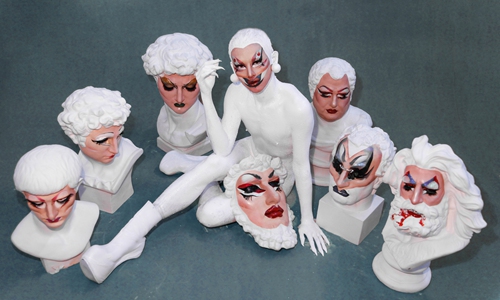HOME >> ARTS
‘Above Extremes’: pursues extreme art of drag
By Ji Yuqiao Source:Globaltimes.cn Published: 2019/12/19 0:26:00

Above Extremes Photo: courtesy of Ling Yang
The artwork of drag "Above Extremes" applies makeup to seven white plaster figures of Western mighty males, including King David, to transfer these heroes into drag queens. The work uses cosmetics to discover the other side of the male heroes.
"Above Extremes" was created by Ling Yang, a student of the Central Academy of Fine Arts based in Beijing. Ling selected seven white plaster figures, which are generally offered to art students to practice line drawing, as his special models in this work.
Dress up a plaster figure to break stereotypes
Ling first coated the plaster figures with foundation to make their faces resemble the color of people's skin and then filled in their eyebrows and added eyeshadow to their eyelids with exaggerated colors such as bright red and gold.
But the decoration of the eyes didn't end there. Ling used eyeliners to draw bold lash lines, and to complete the eye makeup, he topped it off with false eye lashes and mascara.
After applying lipstick to turn their pale lips into flaming lips, Ling completed the transformation of these plaster figures from mighty males to drag queens.
Ling told the Global Times that the males, including King David, who are sculptured as plaster figures represent power in human history.
"They all played a significant role in history and have been engraved in people's minds, so I think they represent the acme of males," he said. "But drag art has always been marginalized and is not recognized by most people. Males involved in drag art are also an excluded group."
Ling added that universally accepted heroes like King David and Julius Caesar are in stark contrast with drag artists, so he decided to create two extremes as extreme art.
Ling is trying to break down stereotypes such as males being chiseled like gods in ancient Greek mythology. "These plaster figures that represent powerful males can also become charming beauties after applying makeup," he said.
Drag needs rebel spirit
"Above Extremes" is not the only artwork about drag created by Ling. He has been researching how to vividly reveal different roles of drag art.
For Ling, doing drag art requires a spirit of "fearlessness." Dare you dress up singularly and stand out from the crowd? Dare you show yourself to others without any embarrassment? "Courage gives the culture of drag vigor."
When he was a little boy, Ling was captivated by the variety of cosmetics and liked applying makeup to his face. But at that time, few people in China could understand the boy's behavior and what was more incomprehensible was that this was a kind of culture.
"My first time dressing up as a drag queen was to watch an opera in the Broadway with several friends years ago. We three were the only drag queens there," Ling recalled. "After the opera ended, we went to bars with other Broadway drag queens."
The experience impressed and touched Ling deeply. He has been fascinated by the art of drag and has tried to explore its core.
He considers the culture to be both pioneering and rebellious among a variety of cultures. "Drag art not only has a sharp visual effect but also has its own cultural core: rebellion and self-understanding."
Ling immerses himself in his work "Above Extremes." He painted white pigment on his body and applied makeup to his face just like the plaster figures. He sits beside them and blends in with them to convert into a rebel of the mainstream.
The culture of drag
A common misconception of drag is that it is always a male portraying an exaggerated form of femininity, but that is not the case. Anyone can do drag and transform themselves into any gender or identity they wish, according to an article posted on vocal.media.
The article said that drag supports LGBT+ communities and helps give a sense of purpose to young queer people as they find others to identify with in the mainstream media.
The culture of drag has a long history. Men have been performing on stage as women since the Ancient Greek tragedies. Even Shakespeare famously cast men as women.
The term "drag queen" was first used to describe men appearing in women's clothing in Polari - a type of British slang that was popularized among gay men and the theater community in the late 19th and 20th centuries.
And while drag has long maintained a powerful presence in popular culture, more recently, it has developed a strong foothold in the art world as well, according to an article on artsy.net.
Posted in: ART